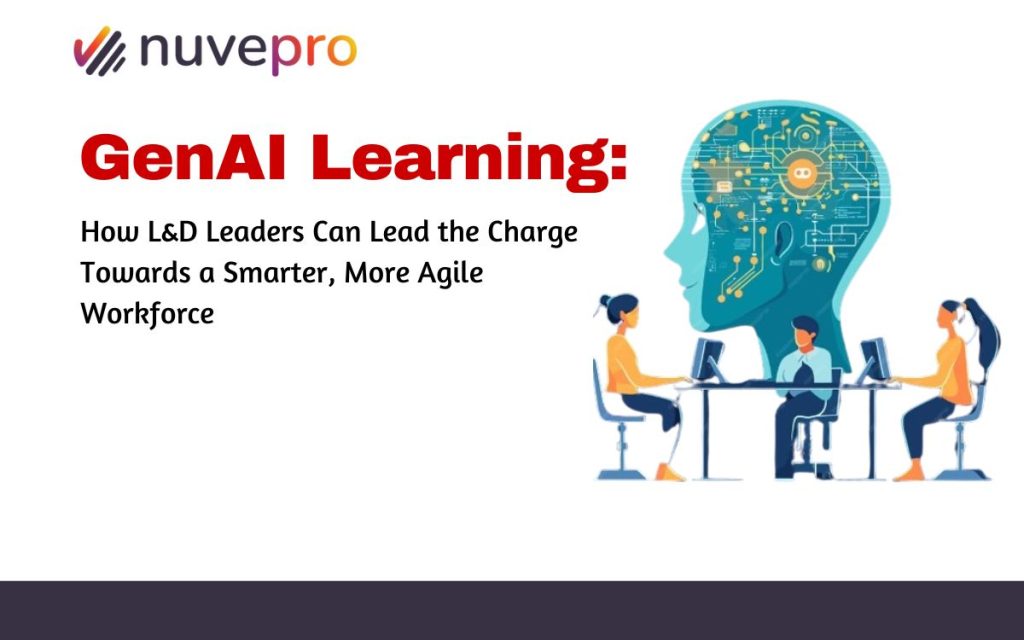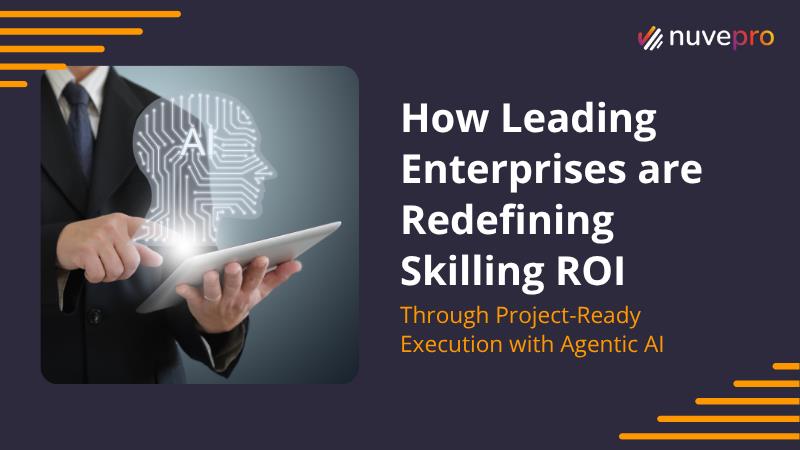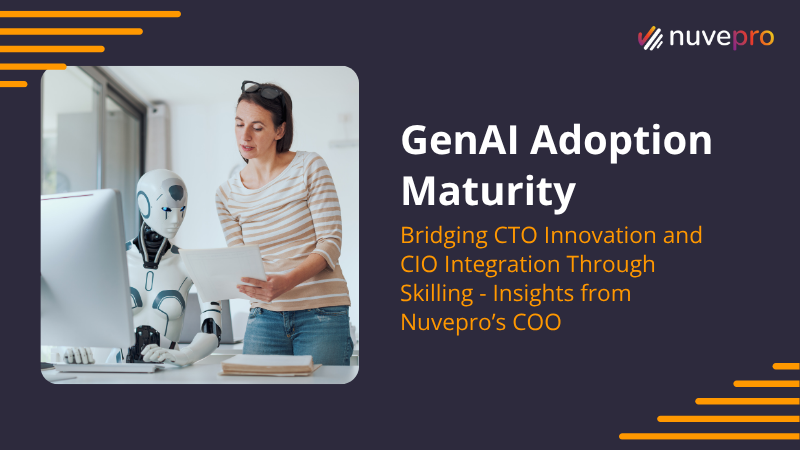Workplace development has been a byte of discussion for quite a bit and technology striding ahead has only led to Generative AI (GenAI) emerging as a game-changer, offering unprecedented opportunities for L and D leaders to shape a smarter and more agile workforce. From augmenting existing tasks to automating repetitive processes and amplifying leadership skills, GenAI courses holds immense potential to revolutionize learning and drive organizational success. As an organisation with a vision of empowering hands-on learning,We, at Nuvepro have already taken initiatives, in not only providing GenAI solutions, but also in making sure the leaders in the organisation are leading the charge in technical skills with respect to GenAI courses. Here, we delve into the transformative potential of GenAI in learning and explore how L&D leaders can harness its power to lead their teams and organizations into the future.
Embracing the Future: Key AI Takeaways for L&D Leaders
Generative AI (GenAI) has increasingly become a topic of interest among L&D leaders, reflecting the growing importance of AI in shaping the future of work. In the recent eBook that Nuvepro wrote over The Confluence of Generative AI & Cloud-Driven Intelligence, key insights were shared on how L&D leaders can prepare themselves, their teams, and their companies for a workplace that not only embraces AI but also leverages the technology in innovative ways by hands-on learning.
Skilling emerged as a fundamental asset for L&D leaders, focusing on upskilling and reskilling of technical skills leading to the transformative processes of how teams can focus on project-based learning. Additionally, business acumen was identified as a critical skill for L&D leaders to understand the challenges facing their organizations and align experiential learning with strategic business objectives. Horizon scanning, the proactive exploration of emerging trends and technologies in the field of L&D, was also highlighted as essential for staying ahead of the curve and driving innovation within the organization.
Prompt engineering and large language model (LLM) application were identified as AI-specific skills that L&D leaders must develop to harness the full potential of GenAI in project-based learning. Prompt engineering involves the creation of effective prompts or inputs to guide AI models in generating desired outputs, while LLM application entails understanding and leveraging large language models to enhance learning outcomes and drive organizational success.
Augment, Automate, and Amplify: Boosting L&D Teams with AI
L&D leaders can leverage GenAI to augment, automate, and amplify their workforce development, thereby enhancing productivity, efficiency, and effectiveness in delivering project-based learning. Augmentation involves leveraging AI to enhance existing tasks and processes, while automation focuses on automating repetitive tasks to free up time for more strategic activities. Amplification entails amplifying leadership skills and critical thinking using AI-driven tools and technologies.
Use case: As a tech leader, when you are looking to upskill your developers, and significantly elevate their efficiency, Generative AI emerges as a powerful solution. By integrating GenAI into your development processes, you aim to achieve remarkable improvements in productivity and output quality. The primary objective is to ascertain whether a developer is “Project Ready,” indicating their capability to fulfil assigned tasks within stipulated timelines while ensuring the security, modularity, and maintainability of their code.
The implementation of GenAI is projected to yield substantial productivity gains, estimated to range between 20% and 50%. At Nuvepro, our methodical approach enables developers to reach this milestone through a systematic progression of skill enhancement and tool utilization. With GenAI, it only becomes easier to deliver high-quality solutions efficiently and effectively.
Building AI Skills Within the Organization
The successful integration of GenAI into upskilling initiatives requires L&D leaders to create a supportive environment for employees to experiment with the technology and develop their AI skills. This isn’t something that happens overnight is something to be considered. What really helps is creating a safe, secured and hands-on learning space of workforce development on GenAI skills.
Secure hands-on learning support from upskilling providers that truly demonstrates the value and importance of AI skills development and helps you in creating a culture of continuous learning and improvement in your organisation.
Other than that, equip your team more on prompt engineering and other capabilities. At the heart of Nuvepro’s innovation lies the proprietary Prompt Engine, the driving force behind the GenAI Skill Bundles. This engine stands as a testament to Nuvepro’s commitment to revolutionizing upskilling and reskilling, particularly in workforce development settings. Designed for hands-on labs that ensure project readiness and job readiness, this engine is built to provide unparalleled compatibility and security, making it an ideal choice for startups focused on reskilling and upskilling initiatives.
The Prompt Engine’s capability to power GenAI Skill Bundles stems from its versatile compatibility with leading Large Language Models (LLMs). This compatibility ensures a comprehensive learning experience, empowering professionals with the knowledge and skills required for project readiness in AI-driven environments.
Moreover, in the rapidly evolving landscape of technology, Nuvepro’s Prompt Engine offers security measures that go beyond traditional upskilling courses. It facilitates dedicated and isolated environments, ideal for enterprises seeking secure upskilling and reskilling platforms. This unique attribute makes Nuvepro an invaluable resource as hands-on labs providers, ensuring their readiness to navigate the demands of the industry.
In essence, the Prompt Engine is not just an innovative technological solution; it’s a catalyst for the transformation of individuals and enterprises, marking a significant stride towards workforce development in the era of AI and technological advancements.
Prioritizing GenAI Skills Training: Benefits and Strategies
- The adoption of GenAI skills is essential for organizations seeking to remain competitive and agile in the digital age. By prioritizing GenAI skills training, L&D leaders can unlock a range of benefits for their teams and organizations, including increased revenue, improved customer support, greater innovation, and enhanced productivity.
- One key benefit of GenAI skills training is its potential to increase revenue and drive business growth. McKinsey estimates that GenAI has the potential to generate trillions of dollars in value across industries through improved productivity, efficiency, and innovation.
- Another benefit of GenAI skills training is its ability to improve customer support and satisfaction. Research from Stanford Business found that AI-driven solutions can enhance productivity, customer sentiment, and employee retention by automating routine tasks and providing personalized support to customers.
Overcoming Challenges and Pitfalls in GenAI Training
While GenAI training offers numerous benefits for organizations, it also presents challenges and pitfalls that L&D leaders must address proactively. Common challenges include technical jargon overload, generic and impersonal training approaches, and resistance to change from employees.
To overcome these challenges, L&D leaders can implement strategies such as encouraging experimentation, measuring impact early and often, delivering hands-on learning on GenAI, and facilitating on the job training and skilling for executives and managers.
Encouraging experimentation involves creating a safe and supportive environment for employees to explore and experiment with GenAI technologies and develop their skills through hands-on learning experiences. Measuring impact early and often enables L&D leaders to evaluate the effectiveness of GenAI upskilling programs and make data-driven decisions to optimize learning outcomes.
Leading the Way with GenAI Skills Training
At Nuvepro our hands-on GenAI Skill Bundles are meticulously designed, catering to precise skill objectives. These programs offer in-depth technical modules, allowing professionals to delve into nuanced AI concepts essential for specialized roles. The tailored approach ensures a focused and impactful learning journey, elevating expertise in specific AI domains. Drop down your enquiry to us on ……. on our GenAI skill bundles and many more and we’d love to chat with you and empower project-based learning for your team.




